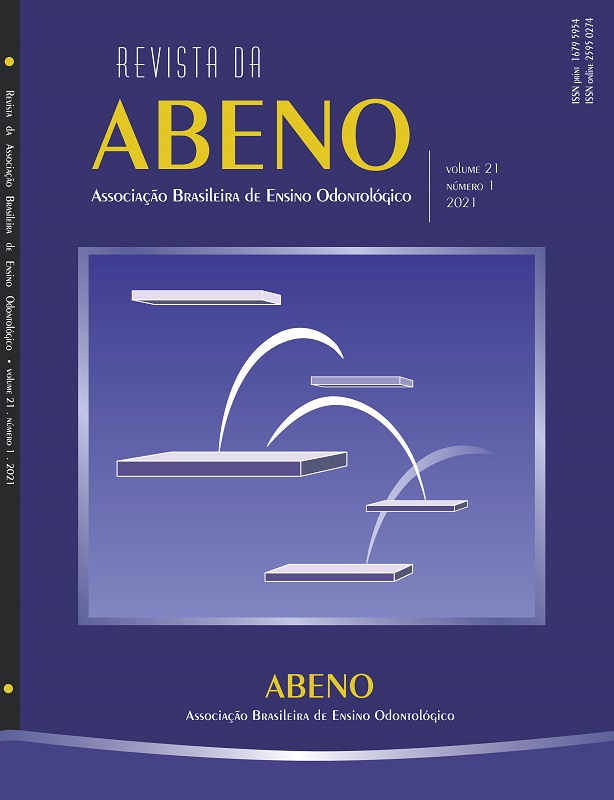Three hundred method in the discipline of physiology in the Dentistry course
collaborative learning
DOI:
https://doi.org/10.30979/revabeno.v21i1.1574Keywords:
Learning, Education, Dental, Students, Dental.Abstract
Three Hundred is a teaching and learning method that seeks to awaken the eyes of the student towards the colleague with learning difficulties, promoting collaboration between students. The objective of this work is to report the application of the Three Hundred method in the discipline of physiology and to compare the performance of students before and after the method. Thirteen students participated in the study and were divided, by lot, into 3 groups. The groups were composed of one student who had above-average grades in a previous assessment and 3 or 4 students who had below-average grades. These groups met in extra classes twice a week for three weeks. In these meetings, students with higher averages helped others in activities that were directed by the discipline's teacher. At the end of the meetings, a new evaluation was carried out. The data were tabulated and analyzed using SPSS version 16. It was found that all students were able to increase their averages compared to the grades of the first assessment. Thus, it is concluded that the method can have benefits in the performance of students, as well as stimulate collaborative learning.
Downloads
References
(1) Deslauriers L, Schelew E, Wieman C. Improved learning in a large-enrollment physics class. Science. 2011; 332(6031):862-4.
(2) Watkins J, Mazur E. Retaining students in science, technology, engineering, and mathematics (STEM) majors. J Coll Sci Teach. 2013; 42(5):36-41.
(3) Deslauriers L, McCarty LS, Miller K, Callaghan K, Kestin G. Measuring actual learning versus feeling of learning in response to being actively engaged in the classroom. Proc Natl Acad Sci USA. 2019; 116(39):19251-7.
(4) Jin J, Bridges SM. Educational technologies in problem-based learning in health sciences education: a systematic review. J Med Internet Res. 2014; 16(12):251.
(5) Dearnley C, Rhodes C, Roberts P, Williams P, Prenton S. Team based learning in nursing and midwifery higher education; a systematic review of the evidence for change. Nurse Educ Today. 2018; 60(1):75-83.
(6) Winkel DJ, Brantner P, Lutz J, Korkut S, Linxen S, Heye TJ. Gamification of electronic learning in radiology education to improve diagnostic confidence and reduce error rates. AJR Am J Roentgenol. 2020; 214(3):618-23.
(7) Hew KF, Lo CK. Flipped classroom improves student learning in health professions education: a meta-analysis. BMC Med Educ. 2018; 18(1):38.
(8) Fragelli RR, Fragelli TBO. Trezentos: a dimensão humana do método. Educ Rev. 2017; (63): 253-65.
(9) Alves GS, Trentin GES, Bignardi C, Machado CDS, Anjos LR, Katata VM. Método dos trezentos: estratégia para minimizar a retenção de estudantes no curso de química. Braz J Develop. 2019; 5(12):33037-46.
(10) Fragelli RR. Trezentos: aprendizagem ativa e colaborativa como uma alternativa ao problema da ansiedade em provas. Rev Eletr Gestão Saúde. 2015; 6(Supl 2):860-72.
(11) Hall JE, Guyton AC. Guyton & Hall tratado de fisiologia médica. 13ed. Rio de Janeiro: Elsevier, 2017.
(12) Singi G. Fisiologia para odontologia: um guia prático para o cirurgião-dentista atender seus pacientes com segurança. 2 ed. Rio de Janeiro: Guanabara Koogan, 2005.
(13) Fragelli TBO, Fragelli RR. Método Trezentos: uma experiência da aplicação na área da saúde. Educ Ci Saúde. 2016;3(1):1-10.
(14) Rodrigues GWL. Aplicação do método 300 no curso de odontologia em Rondônia. Trabalho de Conclusão de Curso (Graduação em Odontologia) – Centro Universitário São Lucas. Porto Velho-RO. 2018. [Acesso em 22 ago. 2021]. Disponível em: http:// repositorio.saolucas.edu.br:8080/xmlui/handle/123456789/3182.
(15) Freire P. Pedagogia da esperança. Rio de Janeiro: Paz e Terra, 1992.
Downloads
Published
How to Cite
Issue
Section
License
Copyright (c) 2021 Revista da ABENO

This work is licensed under a Creative Commons Attribution-NonCommercial 4.0 International License.
Autores que publicam nesta revista concordam com os seguintes termos:
a) Autores mantém os direitos autorais e concedem à revista o direito de primeira publicação, com o trabalho simultaneamente licenciado sob a Licença Creative Commons Attribution que permite o compartilhamento do trabalho com reconhecimento da autoria e publicação inicial nesta revista.
b) Autores têm autorização para assumir contratos adicionais separadamente, para distribuição não-exclusiva da versão do trabalho publicada nesta revista (ex.: publicar em repositório institucional ou como capítulo de livro), com reconhecimento de autoria e publicação inicial nesta revista.
c) Autores têm permissão e são estimulados a publicar e distribuir seu trabalho online (ex.: em repositórios institucionais ou na sua página pessoal) a qualquer ponto antes ou durante o processo editorial, já que isso pode gerar alterações produtivas, bem como aumentar o impacto e a citação do trabalho publicado (Veja O Efeito do Acesso Livre).






